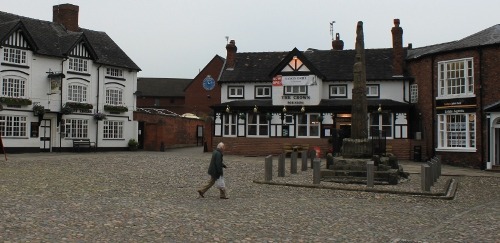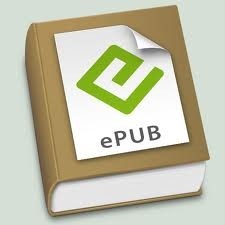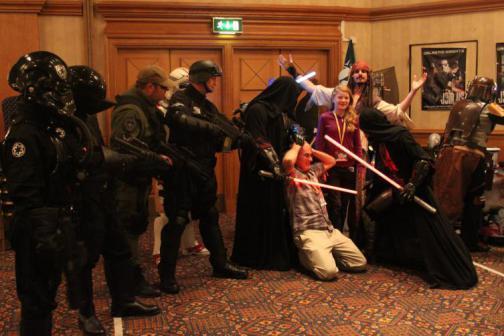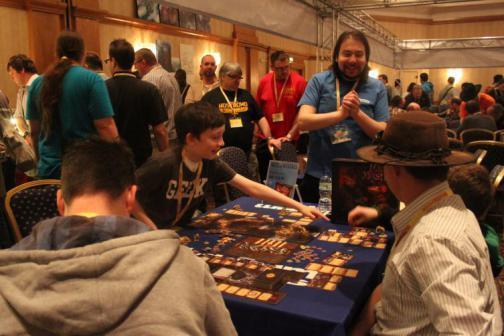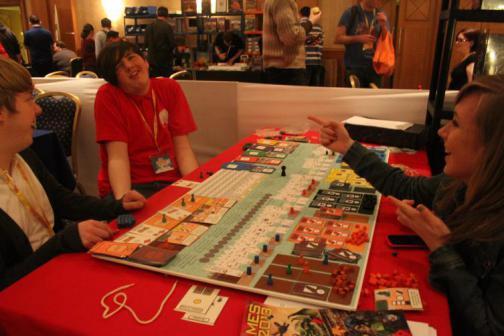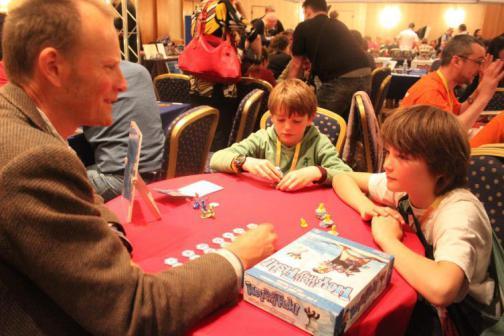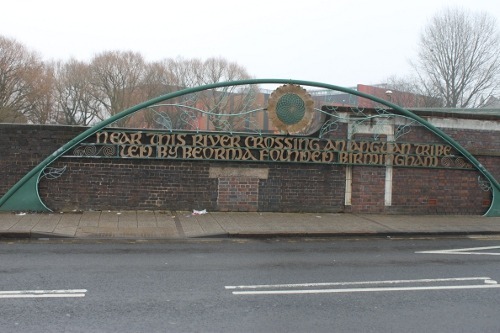Richard Denning's Blog, page 7
June 21, 2013
Mid summers Day
Its is a shame in many ways that we no longer widely celebrate the Mid Summer celebrations focused around the summer solstice in the way we do the winter festivals of Christmas and Yuletide. Here in the Uk there are places that still have special events but it is not widespread. But in a lot of Northern Europe – particularly Scandinavia it is still celebrated. Even here it was once – back in medieval times and Saxon period a major party with lots of celebrations, lighting of bonfires and jumping over the bonfires to ward of evil spirits. It would be celebrated at varying times between 21st and 24th June or the nights before them. The incoming Christian church chose- like they did with Christmas – to celebrate a major feast day on this date. In this case the feast of St John. However despite attempts to rule on what activities were allowed and what was heathen and banned, for many years traditional activities and ritual would still go on.
Everyone likes an excuse to light a bonfire.
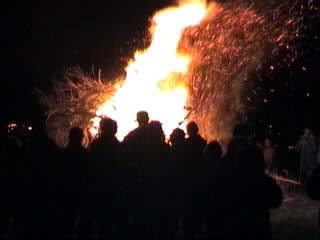
It is still a big event down in Cornwall where the celebration of Golowan is one of the few remaining big MId Summer events in England.
It was once a big part of our calendar and mainly fell away both as a result of Puritan legislation in the days of the Commonwealth and later with the Industrial Era when many people moved away from the country and into the cities. Certainly in Shakespeare time it was still a vibrant event – after all he named one of his plays after it.
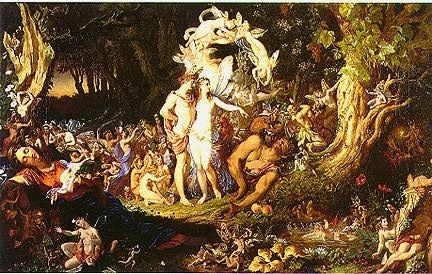
You known I am tempted to go light a bonfire.
June 20, 2013
The Sandbach Crosses
Today I was on the way to deliver a talk to Macclesfield Writers group on historical fiction and self publishing. I had a little time to kill so decided to visit Sandbach. There, in the middle of the cobbled market square of this old market town are two stone crosses of great antiquity. They are at least twelve hundred years old and I wanted to see them as they represent probably the finest as well as some of the earliest Saxon Christian symbols that still survive.
Sandbach is actually a pretty little market town and by chance there was a market going on down the high street theu still call the Crosses Market. The town centre is this little square surrounded by pubs and half timbered buildings some of which date back to the 16th century and earlier. However it was the crosses I wanted to see as these predated anything in that square by at least half a millennia.
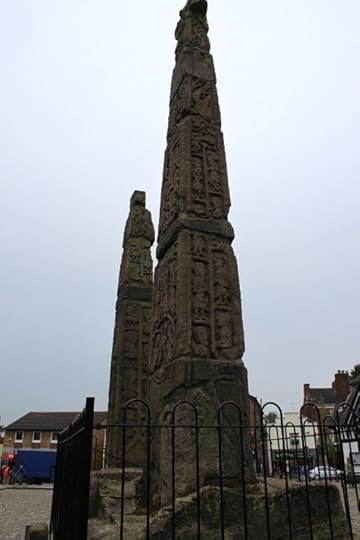 There are two crosses at Sandbach. They are richly engraved with biblical scenes, creatures and vines and must originally been an amazing site. What do we know of their origin and age? The answer is actually very little.
There are two crosses at Sandbach. They are richly engraved with biblical scenes, creatures and vines and must originally been an amazing site. What do we know of their origin and age? The answer is actually very little.
The earliest documentary mentions of the crosses is by William Smith who was the Rouge-Dragon Pursuivant at Arms of Elizabeth I, who was originally from nearby Nantwich. In 1585 he wrote about the crosses: ’two square crosses of stone, on steps, with certain images and writings thereon graven [standing] hard together.
So by that year they were already in place. But when were they constructed? There are legends of the crosses dating back to the 7th century and having been erected to mark the conversion to Christianity of the pagan king Penda of Mercia. However the most accepted view – based upon an analysis of the forms and style of the inscriptions – is that they date from the 9th century. The larger cross was probably carved in the first half of the ninth century and the smaller cross was completed slightly later. It is most likely that the crosses were brightly painted.
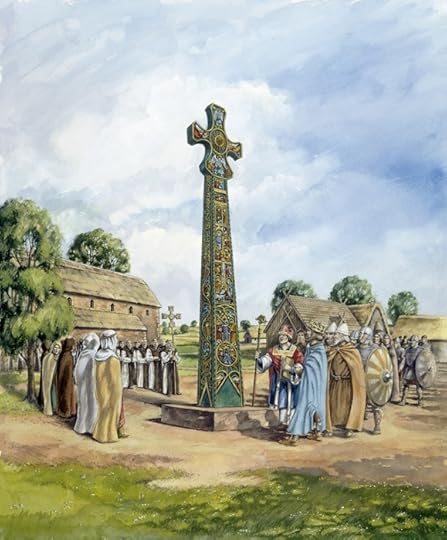 The current theory is that a religious institution of significance must have existed in the area and that the crosses were a focal point of veneration and worship. However no documentation exists to support this – but then again there is a profound lack of documentation for this entire period.
The current theory is that a religious institution of significance must have existed in the area and that the crosses were a focal point of veneration and worship. However no documentation exists to support this – but then again there is a profound lack of documentation for this entire period.
What we do know is that at a later period the crosses attracted the ire of the 17th century puritans and during the Commonwealth were knocked down and the components strewn around the area. One hundred and fifty years later in the early 19th century they were collected together and in 1816 were reassembled at the present site.
June 12, 2013
The First Anglo-Saxon Law Codes
In the first decade of the 7th century, King Aethelburht of Kent laid down on parchment the first set of Legal Codes that survive from the Anglo-Saxon period. The codes still exist although in a copied volume of law codes and genealogical records called the “Textus Roffensius” – the Rochester Book – which was made and held at Rochester Cathedral around 1120. This document gives us our first glimpse of laws and legal traditions from the Saxon Period.
[image error]
One fundamental principle of these law codes that date back to Germanic and Anglo-Saxon traditions is that of Weregild and compensation. In essence these laws laid down the means whereby a man guilty of a crime would be expected to pay a fine to the victim. In our modern world where first of all we look to punish crime by imprisonment or (until the 1960′s) death in the case of murder, the Saxons took an approach that tried to avoid a blood feud.
To understand this one has to think back on years where these law codes evolved. In the chaotic and bloody years of the Anglo-Saxon settlement and probably drawing from earlier traditions in the Germanic homelands when there was no real legal structure, it would be very easy for harm to a man to be avenged by the victim’s family. This could easily lead to tit for tat retaliation. So in those years the principle of a ‘weregild’ evolved meaning literally man’s worth . Every man has their weregild. If they died at another man’s hand the value of this would be paid to avoid retribution.
For centuries the exact values of weregild were recorded and passed on orally or if written down we have no record of it. This first legal code of Aethelbehrt gives us a snapshot of these fines as they existed during his time.
‘If someone slays another man he shall pay-over a proper compensation of 100 shillings.’ The code even goes on to specify that 20 shillings must be paid over the grave as the man was being buried and the rest within 40 days.
Not all men are born equal in these codes. A slave killed would leave to compensation of between 40 and 80 shiilings dependent on the value of the slave.
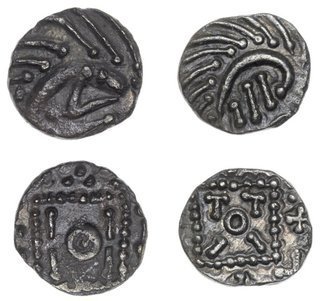
The law codes are incredibly elaborate and do not just talk of fines for murder. In fact they go on to specify just about every conceivable injury:
‘If the ear is pierced the compensation shall be 3 shillings’
‘If the eye is put out the aggressor shall pay in compensation 50 shillings’
‘For each finger nail, a shilling’
There is even an attempt to establish rules for separations:
‘Is she (a wife) wishes to leave with the children let her have half the money’
and adultery:
‘If one freeman lies with another’s wife he shall render the weregild (code is not clear how much) and procure with his own money and second wife for the man. ‘
The codes also cover property damage, trespass and other areas of non violent crime:
‘If someone is first to force his way into someone else’s premises he shall pay in compensation 6 shillings, the next 3 and each subsequent man 1 shilling’
‘If someone seizes goods whilst inside he shall pay back three fold’
These codes do something else which is vital in the development of the land that will one day be called England. It establishes the authority of the King, places the king at the heart of the law and also provides revenue for the crown. Many of the codes deal with much larger and heavier fines due to the King in the event of harm to him or his property or household:
‘If a freeman steals from the king he shall pay back ninefold.’
Any crime committed near the king, in his presence or even in the same locality whilst he was resident would lead to fines being paid to the king in addition to the weregild going to the family of the victim. A king was entitled to compensation for every freeman killed. ’50 shillings shall go to the king as compensation for loss of a subject’
This approach did not just extend to the King. Aethelburht was the first Anglo-Saxon King to convert to Christianity and, mindful of potential threat to the incoming missionaries from reluctant Saxons, he enshrined within his codes protection for the church and its property: ‘God’s property will be compensated 12 fold’ This meant he was placing a very clear higher value on he church than himself.
What we see here is the beginnings of a formalization and drawing under state control the legal systems. Later codes such as those of Alfred the Great and others would establish legal courts and elaborate on these basic codes but this set of laws written 14 centuries ago are the earliest striving towards an orderly state that we have any record of.
There is a superb book on this subject called Early English Law by Bill Griffiths. Weregild is a theme in The Amber Treasure – a story of Treachery in Dark Ages Northumbria.
June 7, 2013
Google E-books short cut – making Epubs the easy way
In the world of e-books the ePub is the industry standard. It is the file that creates the ebook but it is in fact not one file but possibly dozens. If you unzip an ePub file and examine the contents you find that there are a number of different elements. There are html pages for each chapter, images, style sheets that dictate how the book appears and most importantly the contents.opf which is basically the master control file that pulls it all together.

Now all this sounds complex and getting an ePub to work can be a challenge and lets face it authors want to focus on writing not tinkering with html pages. However I needed to find a reliable means to creating Epubs quickly that I could upload on Google Books as that platform is fast becoming one of the largest suppliers of e-books world wide. I already put my books on Kindle and via Smashwords onto Nook, Kobo, Sony and Apple but you need to be able to upload directly to Google. You can just upload a pdf but if you do that the book is not scalable. That means it will not shift and resize to fit the various ebook readers , including smartphones that people might use. Google ebooks NEEDS an Epub.
Smashwords is the answer. This service is brilliant and via it my eBooks reach a wide range of platforms as I have already said. But not Google. However if you format your word doc and pass the Smashwords style guide and get accepted for premium distribution then in the process you will find Smashwords creates an Epub. You can download this file and use it elsewhere.
Little Tinkering Required
So you have created a book on Smashwords and the meatgrinder has generated the book in various formats. As author you can download the book. So go grab the ePub. Then unzip it. Find the Contents.opf file and open it in Notepad:
Here you need to find the entry that lists the publisher and change it so it reads
Richard Denning
Or whatever you want the publisher to be. . Save the file.
Now find the html file that contains the copyright statement. You may need to dig around the various html files to locate the one. Again open in notepad and this time change “Smashwords edition” to Google Ebooks edition and publisher from Smshwords to whatever you want it to be.
Save that file. Now you need to zip up the epub. Here there is a trick. You have to zip up the entire folder but one file – called Mimetype must NOT be compressed. This may require fidling with your zip programme I have a easy solution here. I downloaded and installed a neat little programme called epub pack. Install it. Then run it. Select the mimetype file and chose an output file name – maybe “mybook.epub” and click make epub and in an second you have a bright shinny new epub with copyright details etc correct for Good Ebooks. You can use the same process to create the ePub to upload to Kindle.
 So the take home message is to spend the time formatting and getting it right for Smashwords and then just use that work to create these other files. There are limitations to this approach as the Smashwords Epub file is basic and creating the books in other programs is ultimately the way to create more shinny and slick epubs but this method I here describe allows you to get books quickly into epubs and out onto Google Books.
So the take home message is to spend the time formatting and getting it right for Smashwords and then just use that work to create these other files. There are limitations to this approach as the Smashwords Epub file is basic and creating the books in other programs is ultimately the way to create more shinny and slick epubs but this method I here describe allows you to get books quickly into epubs and out onto Google Books.
If it all goes wrong there are online Epub checkers that you can us eto check your epub file for errors but I also find installing Adobe Digital Editions and opening epubs in that allows you to check the books.
May 28, 2013
Riding the Roller-Coaster: Running UK Games Expo
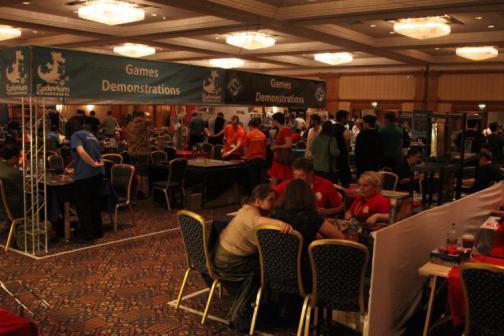
This last weekend was UK Games Expo 2013. This was the 7th such event but the first in our new venue the Hilton Metropole Hotel at the NEC, Birmingham. UKGE is the UK’s largest hobby games convention with 3500 individuals attending, most for 2 or 3 days and a total footfall of around 6000. There were almost 100 traders and publishers or exhibitors showing the newest and most exciting board games, card games, roleplaying games and miniatures. Alongside all this we had a host of costumed groups, hundreds of seats in roleplaying games and tournaments in 20 different games including big national events like the 60 player Xwing UK Nationals and the UK Settlers finals both of which send winners to European and World finals in the USA, Vienna or Germany. It is big, noisy and exciting and from all the feedback everyone had fun despite the price of beer!
For the organisers this was the result of two years of planning. The journey began at Expo 2011 when Larry Roznai the C.O.O of Mayfair games made it across for the first time to Expo. He liked what we were doing but told us that the event could be bigger and better if we were willing to take the risk and move to a larger venue. Larry has vast knowledge and wisdom in such matters and his advice sent us to the Hilton. By co-incidence on the same day I emailed the Hilton they emailed me. They had heard of us and were looking to attract us to them. So we went and saw them. Now we did honestly warn them about the sheer scale of what we had in mind but I think – to be frank – they did not really believe us. They are used to trade Cons and fan based events but really the largest Hobby based event ( DR Who and Terry Pratchett events) have till now attracted just about 400 folk. THAT is what they thought they were getting. I think they are still in shock after we opened the door and pushed 3500 people at them.
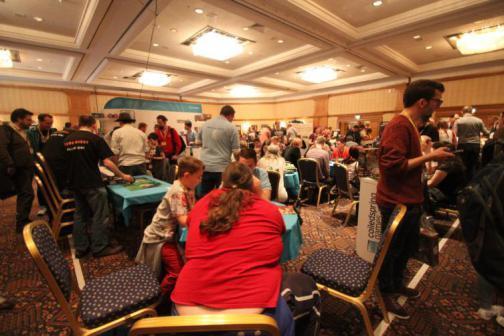
The planning was done by a team of 5 of us – those of us in the Burgundy or as we like to say Imperial Purple shirts: John Dodd handles the RPG event schedule, Mick Pearson looks after our army of volunteers, Pat Campbell manages transport as well as some of the PR work. they all attend a number of meetings in the year as well as keep in contact through email and sometime skype. The vast bulk of planning of the floor plans, sorting stands out, timetabling the weekend and doing the huge Tetris game that is fitting Expo into its space is my role. Tony Hyams has the other wedge of planning and implementing the IT side of the show, ticketing, website as well as being more practical than I about physical solutions to problem. For example he designed the stand dividers as we needed a low cost alternative to expensive shell systems. We two are the directors of UK Games Expo Ltd and share the actual financial risk.
If you are thinking of running such an event I would say THINK HARD. Running Expo is not a job for the faint-hearted. I receive something like 4000 to 5000 emails a year and send out maybe 3000 a year for Expo. The great bulk is from Essen Spiel onwards, particularly the 2 months before the Expo when I can easily send and receive 50 emails a day. I am a GP in real life and Tony a church minister so this work load has to be fitted in around that. Things have got to the stage that Tony and I often spend 2 or 3 hours on skype on 2 or 3 nights a week for 4 or 5 months. Many nights we see 3am arrive before we call it a night – knowing we both have to be up for the day job in a few hours. I find I need to scatter a week or two of days off around the two months before Expo just to give me time to keep on top of everything. On top of the sheer workload anyone thinking of running such an event needs to think hard about the finances. The early years of Expo involved a personal risk of maybe £5000. The move to the metropole potentially raised that risk to tens of thousands. So it was an anxious year and we are certainly relieved that the gaming community supported the event. If you heard Tony at the awards ceremony thanking you for your support that was heartfelt by us all and in particular us two.
So how did we get the numbers along? Well this sort of event needs to grow. You don’t just get the people to turn up. Getting the trade along is the first trick. This is the result of work going back to as far as 2006 when Pat Campbell and I hauled ourselves around stands at Essen, visited Midcon, Manorcon, Dragon-meet, Triples and Salute and many other events. Traders who have attended year on year since those early days need a particular thankyou for taking a chance when an unknown bunch of guys came to see them with a mad idea about a UK event based around Essen, Origins and Gencon Indy.The Expo model is not particularly common in the UK and many wargames traders in particular don’t really “get” the concept of demo games linked to stalls, ongoing events over 3 days, seminars and guests etc. We did not want to set up in a gym and present a trade show that looked like a car boot sale and lasted 4 or 5 hours. These are mostly soulless affairs with no buzz. We wanted it to be vibrant, colourful and exciting. We wanted families. We wanted costumed groups and people to come all weekend. We wanted community. That was at times a hard sell I can tell you.
Then of course we needed to get the visitors along. Here we put in a vast amount of work year on year on Facebook, Twitter, Google Plus, our own website, our newsletter, various forums and so forth. WE attend other events like Essen, Dragonmeet, run events at the local shopping center or the Middle Earth Weekend and talk to the public. We pay for local newspaper advertising and look for coverage in a variety of online blogs etc.
The actual Expo weekend starts for us about a week earlier when we switch off the booking and Tony prints and collates almost 900 orders as well as doing packs for volunteers etc. Meanwhile I am busy printing off final floor plans, table counts and so forth. Pat and Mick are usually busy doing errands like banking and finalizing Volunteer arrangements, John organsing his GM’s. We got the vans on the Tuesday and started loading the board game library and 40K terrain from our club. Wednesday last week saw us loading 300 wooden boards, acres of cloth and a vast ammount of other stuff from our storage garage. WE then stuffed 300 Goody bags which took 3 or 4 hours for about 12 of us.
Thu we arrived at the hotel, set up HQ, had a briefing meeting and then went into the Trade Halls around 10pm to mark them up. That last job took Tony and 3 others 7 hours. He went to bed at 5.30a.m. about 1 hour before I got up with the other purples to get the tables in. Starting at 8am Friday it took 4 hours to set up the tables for the Trade halls and still more time the tournament rooms. Meanwhile our front desk were already letting in the hundreds who had arrived to game.
It was hard work but when we ran out of Saturday tickets and Lanyards (we had 3000) we knew were wer OK – the plans were working and the support was there. I think it was about 12 noon on Sunday when I was able to actually look round the show free for about an hour of any issues and buy some stuff. As walked around with the goodies I was buying, I thought to myself “We did alright, didnt we”.
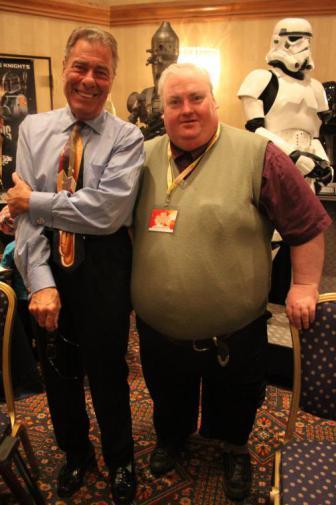
Our Dr Who guests John Levene and Simon Fisher-Becker
Overall the feedback has been massively positive. We know about the beer and food issues, need to do more with parking and trader access, open gaming space etc. Many little things need fixing but that is event management. Replicate what worked, fix what didn’t. Most feedback is sensible and constructive, You always get some folk who think they are instant experts on what we should do better but most guys say common sense things. But so far on facebook, twitter and email the guys who think we did a good event outnumber the moaners by 20:1. I can live with that.
So after the dust settles we get a few months off now and then the roller coaster begins again.
April 30, 2013
The Internet is 20 Years old
It is extraordinary to think that this simple site is where it all began – the World Wide Web is 20 years old and this was what is first looked like http://info.cern.ch/hypertext/WWW/TheProject.html
20 years ago today, on April 30 1993, CERN allowed open access to the technologies underpinning the World Wide Web. Although Tim Berners-Lee a worker at CERN had actually invented URL (website addresses) and hypertext protocols (clickable text that linked one document to another document) a few years before THIS was the day it all became public. It is interesting to think that CERN COULD have kept all this to themselves and we would not today be using Facebook Twitter and Amazon etc.
This news sent me back through time to the moments when – believe it or not I was an Internet Pioneer! I read about this new invention the World Wide Web when I was messing about on my computer connecting to bulletin boards in search of DOOM and other such games. I thought WOW THIS is the future, I actually had set up my very first website with Tolkien related, roleplaying and wargames material on it within within a few months of learning about this and my – long since defunct Demon Internet site – was one of the first few hundred in the world.
It is strange to think back to those early days when most people I knew did not even own a computer and friends would come and stay for a night just to play on mine. Certainly there were no tablets or mobile phones with any internet ability at all. As a result those of us active on the net used to find ourselves in very weird cyber locations and I used to get most visits from US military sites and lots of Finnish people. Early adopters the Fins maybe because there aint much to do in the winter! I wish my site still existed as there was some cool roleplaying adventure stuff that date back to university days on it.
Many people have since learnt a lot more about building internet sites than i will ever know or understand but back then i was briefly almost an expert. Indeed it is a bit like comparing today the complexity of a modern car with the early days of cars when a man could understand his car engine and rebuild it. Indeed he had to because often garages were few and far between. In those early days there were NO PC worlds. NO high street shops which sold PCs. You had to build your own PC, understand and code many of the tiles needed to run it (Remember DOS, Autoexec.bat. Config.sys Expanded and Extended memory?). Indeed my first PC had 40MB of Hard drive space and 4MB of Ram. We sure have come a long way in 20 years.
So its an odd reminder today of when I was 25 and charting the new exciting world of the World Wide Web.

March 29, 2013
Easter – how the Anglo-Saxons merged Christianity and their pagan past
Easter is upon us. It is of course the greatest of the Christian festivals, celebrating the death and resurrection of Christ. In most of the non English speaking world the world used for this festival is one form or another of Passover. For of course the death of Christ occurred at the time of the Passover and the Apostle Paul even refers to this in Ephesians. ”Christ our Pascha has been sacrificed for us.” Pascha here meaning passover.
Yet in the English speaking world the title for this festival is Easter. What is curious about this is that this is another example of where in the incoming Augustine mission and their successors did not abandon the pagan past but adopted it and built upon it.
Bede (672-735), the monk and great chronicler of the English Church talks about this in his work De ratione temporum (The reckoning of time). He works through the months of the Anglo Saxon year commenting on them and the pagan rites associated with them.
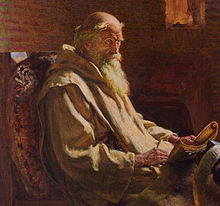
When he reaches April he says this: “Eosturmonath has a name which is now translated “Paschal month”, and which was once called after a goddess of theirs named Eostre, in whose honour feasts were celebrated in that month. Now they designate that Paschal season by her name, calling the joys of the new rite by the time-honoured name of the old observance. “
So then. According to Bede, Easter is named after the goddess Eostre. Now some historians pour doubt upon this and say that ONLY Bede mentions this. There are two main arguments for saying that Bede did not make it up. First very few documents survive from this period and so just because nothing else is written down does not mean it is not true. Bede had an agenda of his own – mainly trying to prove that that the Roman Augustine Christian church had authority and that the Welsh church should bow to it. So often you have to take what he says as a bit of propaganda BUT he has no particular reason to lie here.
Secondly whilst Bede is the only ENGLISH reference the Old English goddess Eostre is replicated across the Germanic, Norse world and further in forms like Ostare, Ostara, Ostern, Eostra, Eostre, Eostur. She is a Fertility goddess and there are associations with new birth and the dawn. If we dig further back we find that the origins of the name Eostre is indeed a word for dawn or new light.
What do we know about her? Well, traditional symbols associated with Ostara, the Germanic equivalent to Eoster are eggs, lambs and bunnys - not surprising as these are all symbols of new life and fertility. So a celebration of the return of the sun at the Spring Equinox is what seemed to go on. When the length of the day equals he length of the night our ancestors thanked the gods with festivals involving these symbols. So giving and receiving of eggs replicates an ancient tradition. Chocolate versions are of course much more modern.

The name though is possibly even more ancient. The is much speculation at this point but the Indo-European languages of course originate in the Fertile Crescent. So this same word can probably be traced back to something like 2000 BC to the Babylonian goddess of Sexuality, fertility and birth Ishtar which is pronounced in a way very close to the English word Easter. Again her festival was celebrated at the Spring Equinox, and celebrate her return from the land of the dead where she went in an attempt t bring back her lover. Possibly then a theme of resurrection and new life can be seen there but this may be stretching the point. Certainly her festival is at this point in the year, she was a fertility goddess and Eostre can maybe be traced back to her.
So then some aspects of Easter do have elements of our Anglo-Saxon, Germanic pagan past with echoes perhaps of something older. Now when we look at England in around AD 597 and the years thereafter we see that the Augustine mission had two choices. It could ban Eostre/ Easter or as it coincided with the Passover adopt and absorb it. A similar process and challenge faced Christianity as it moved into Germany. Jacob Grim, one of the Brother’s Grim and not just a fairy tale writer but an academic comments on this as it occurred in ancient Germany:
“We Germans to this day call April ostermonat, and ôstarmânoth. The great christian festival, which usually falls in April or the end of March, bears in the oldest of old high German the name ôstarâ …. This Ostarâ, like the [Anglo-Saxon] Eástre, must in heathen religion have denoted a higher being, whose worship was so firmly rooted, that the christian teachers tolerated the name, and applied it to one of their own grandest anniversaries.”
Elsewhere Grimm says:
“Ostara, Eástre seems therefore to have been the divinity of the radiant dawn, of upspringing light, a spectacle that brings joy and blessing, whose meaning could be easily adapted by the resurrection-day of the Christian’s God. Bonfires were lighted at Easter and according to popular belief of long standing, the moment the sun rises on Easter Sunday morning, he (the worshipper) gives three joyful leaps, he dances for joy
It is clear that the Church, as it moved into Anglo-Saxon and Germanic regions just adopted these celebrations in the same way as they did the pagan Yuletide. Not by banning it but taking elements that they could accept – symbols of life and light and joy and purity and incorporating them into their own festivals. A pragmatic approach that works. So much so that it can be hard sometimes to separate Christian elements from Pagan elements.
So then. Happy Easter, glæd Eosturmonath !
Easter – a Christian festival based on a pagan past
Easter is upon us. It is of course the greatest of the Christian festivals, celebrating the death and resurrection of Christ. In most of the non English speaking world the world used for this festival is one form or another of Passover. For of course the death of Christ occurred at the time of the Passover and the Apostle Paul even refers to this in Ephesians. ”Christ our Pascha has been sacrificed for us.” Pascha here meaning passover.
Yet in the English speaking word the title for this festival is Easter. What is curious about this is that this is another example of where in the incoming Augustine mission and their successors did not abandon the pagan past but adopted it and built upon it.
Bede (672-735), the monk and great chronicler of the English Church talks about this in his work De ratione temporum (The reckoning of time). He works through the months of the Anglo Saxon year commenting on them and the pagan rites associated with them.

When he reaches April he says this: “Eosturmonath has a name which is now translated “Paschal month”, and which was once called after a goddess of theirs named Eostre, in whose honour feasts were celebrated in that month. Now they designate that Paschal season by her name, calling the joys of the new rite by the time-honoured name of the old observance. “
So then. Easter is named after the goddess Eostre. What do we know about her? The Old English goddess Eostre is replicated across the Germanic, Norse world and further in forms like Ostare, Ostara, Ostern, Eostra, Eostre, Eostur. She is a Fertility goddess and there are associations with new birth and the dawn. If we dig further back we find that the origins of the name Eostre is indeed a word for dawn or new light.
Traditional symbols associated with Ostara, the Germanic equivalent to Eoster are eggs, lambs and bunnys - not surprising as these are all symbols of new life and fertility.

The name though is very ancient. The is much speculation at this point but the Indo-European languages of course originate in the Fertile Crescent. So this same word can probably be traced back to something like 2000 BC to the Babylonian goddess of Sexuality, fertility and birth Ishtar which is pronounced in a way very close to the English word Easter.
So then some aspects of Easter do have elements of our Anglo-Saxon, Germanic pagan past with echoes perhaps of something older.
March 7, 2013
Beorma-Ingas-ham – The Anglo-Saxon origins of Birmingham
Today Birmingham is of course the second largest city in the UK. Home to 1 million people and part of a huge conurbation of several million, its size and growth owes much to the Industrial Revolution for here and in the nearby Black Country many of the goods that helped build the British Empire were manufactured and certainly most of the guns.
But like with so many of our towns and villages the name Birmingham and its origins can be traced back fourteen or fifteen centuries to around the year AD 600. These are the years when thousands of Anglo-Saxons are crossing from Germany and Denmark and pushing west, creating a land that will one day be called England. The people who founded Birmingham are the Angles. Tradition says that the Angles who came to Mercia crossed the North Sea in around 527 and are thought to have reached Birmingham around the late 6th or early 7th Century. There they founded a hamlet on the banks of the River Rea at or close to the spot where the modern Gooch Road crosses the same river.
Who ever the people were that came here seemed to have been led by a man called Beorma. The name Birmingham comes from Beorma -Ingas-ham. That is old English and means “The settlement (ham) of People (ingas) of Beroma.” It is quite common to find Anglo-Saxon villages and towns named after the person who founded the settlement:
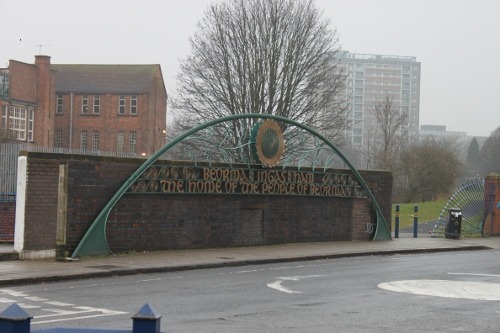
Today the spot is marked by this arch on the Bridge. The area- Highgate – is mainly tower blocks and modern housing estates and it is hard to imagine the place as once upon a time being a tiny Anglo-Saxon wooden village surrounded by dense woodland but non-the-less it is here that the origins of Birmingham start.
February 15, 2013
How big things become small
A day off today. Spent it researching Saxons in Tamworth library. I was trying to find any early evidence of Saxon settlements there. As I thought there was not much evidence before Offa made the place one of his halls. But the Norman castle site was within the confines of later Saxon fortified Tamworth and I am sure it would have been obvious location for earlier settlements – elevated ground near a river crossing.
I also had lunch in market Bosworth. I used to live a few miles away as a child in the village of Fenny Drayton. Growing up I was aware of the battle of Bosworth as my school was not far away in Stoke Golding (local legends speak of burials at Stoke Golding and the injured being treated in Fenny Drayton.) Going back it seemed a small place. I recalled it as much larger when we would visit occsionally.
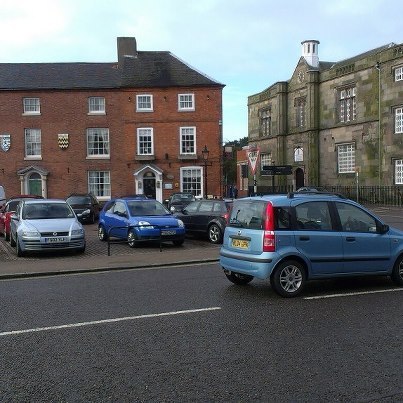 This got me thinking about how perceptions change between childhood and later life. How often do you go back to a school that seemed HUGE when you were a pupil and now it is tiny in your eyes.
This got me thinking about how perceptions change between childhood and later life. How often do you go back to a school that seemed HUGE when you were a pupil and now it is tiny in your eyes.
Has anyone had similar experiences? I wonder why that happens.



